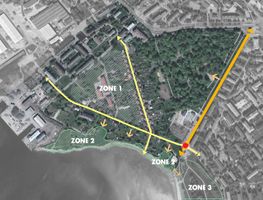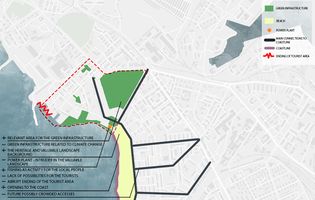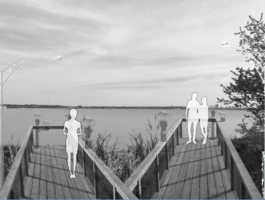Case Study C: Cemetery Park
>>>back to working groups overview
Rationale
- Why do you think this case is relevant? What is your hypothesis considering the landscape challenges?
- Format: 3-4 sentences
MAGNET - RESILIENCE - RECREATION
As Tallinn is a city by the sea it is important to keep the coastline natural as possible but still accessible to use for the citizens. Open spaces near coast gives opportunities to develop new recreational areas. Coastline will be moved towards the land (consequence of the climate change) > it requires a proper planning strategy resulting in a resilient coastal landscape.
Location and scope
You can edit this map with the map editor
A Landscape System Analysis
A.1 Landscape layers and their system context
Geomorphology, landscape units and coastal typology
- The coast of Talinn is 46 kilometers long, Kopli peninsula being part of it. Its borders are comprised of three bays: Talinn, Kopli and Paljassaare. Located in the suburb of Kopli, Kopli cemetery opens to the beach. Regarding the coastal typology, till coasts make 8% of the shoreline length, sandy coasts – 33%, silty coasts – 8% and cliffed coasts – 51%.
- The geological history is related to the isostatic uplift of the Earth’s crust in the northern part of the Baltic Sea region, which still continues (ca. 2 mm annually). The coastline is made up of rocks and sediments of till, varved clay, sand, gravel and pebbles. Their origin is glacial, marine and lacustrine and dates from various periods of time. The soft rock bluffs of Quarternary glacial drift deposits is the most specific for the Kopli peninsula. Due to the uplift of the Earth’s crust, the character of the Estonian coast and beaches is emergent.
- The main driving forces for the coastal typology changes are naturally and human based. On one hand, we can talk about the wave activity and the wind-induced surge during storms that along with the global warming may be the cause of future changes. On the other hand, human exploits are equally important in causing typological damages, this being the first factor that we are able to control.
Land use
Kopli Cemetery park case study area is a combination of:
1. Discontinuous urban fabric
2. Green urban areas
3. Agricultural, semi-natural areas
4. Industrial or commercial units
5. Port areas
6. Dump sites
7. Railways and associated land
8. Land without current use
Most predominant land uses in the case study area are industrial/commercial units with dense resident areas. Through time there has not been many significant changes much bring out. In the connection areas however land cover maps from decades ago is showing how port areas is converted into the Industrial commercial units. Analysis of the area and City planning documents shows how the surrounding area has different architectural buildings from different time periods. Most closest and important to bring out is single family house area that is located west from the Cemetery park in Sirbi street. It is also documented as a mileu valued space in Tallinn.
In the future Kopli cemetery park and its connecting areas could be in even more ugly state than its today. Old buildings are abandoned or not in good shape. A lot of old Industrial building ruins has no meaning right now with also bigger grass areas around them that are not maintained.
Land use changes from 1990 to 2018 (CORINE Land Cover map) [[1]]
Green/blue infrastructure
- What are the major potential elements of a green/blue infrastructure network? Are these likely to change/disappear? Why is that?
- You find my background material on green infrastructure in our reading list
Green infrastructure In this study area, there are parks, coastline park, and private gardens. The largest park is Kopli Cemetery Park is the main element of green infrastructure and magnet as well. Nearly 85% of this area is covered by green spaces and green areas, coastline and natural areas as well will be connected to a uniform citywide network. The coastline park with a lot of empty spaces so there are several potentials for recreation connected to the coastline area.
Actors and stakeholders
- Who is driving changes in this landscape? Who is affected by those changes?
- Draw a stakeholder and/or power map: Who is affected highly but with low power? Who has high power but is not affected?
Sacred spaces and heritage
- Which places/elements hold cultural value and to whom?
- You may add a map and some images, please also explain in your caption why these elements are valuable
Seeside:
Lighthouses Meeruse sadama sihi ülemine tulepaak ("upper lightbulb") and Meeruse sadama sihi alumine tulepaak ("bottom lightbulb") - existing light houses operate as a typical coastal landmarks which characterise the landscape.
Urban forest:
Kopli Park is a former Cemetery called “Friedhof von Ziegelskoppel“- the biggest necropolis (Lutheran Baltic German cemetery) in Estonia, established in 1774 and destructed in 1951 by Soviet authorities. Also many prominent Estonian citizens were buried here. No trace of the cemetery was left standing. The gravestones were used to build walls and sidewalks in other parts of the city. Kopli Park has for sure strong and clear cultural value for the Tallinn citizens. Former cemetery has a great value for the older/passing generations of Estonians. Young generations possibly do not inherit the attitude to the past form of the Kopli Park.
Visual appearance and landscape narrative
- The representation of the area start from the postcards: through this type of representation we can studied the evolution of the landscape and we understand how the coast is the principal element, not only of this project area, but of the entire city.
- The paintings, mostly realized during the romantic movement, shows not only the atmosphere that served to describe the coast, but also the importance of the subjects: the boats, considered element of connection with other countries and element of maritime trade. In particular the painting by Evald Okas, "Kopli rand" from the 1930s, is characterized by a different atmosphere from the others, represents part of the project area, and we could assume that the boat represented could belong to one of the fishermen who live nearby.
- The b&w photos represent the Kopli cemetery in the past, razed to the ground later by the Soviet power present in Estonia. This is an important element for the area of study because the remains of the tombstones, have been used for the construction of sidewalks and walls of other parts of the city. This 'narration' connects the project area, and more the rest of the city.
- 'File:''.''
A.2 Summary of you landscape system analysis and your development Targets
- You can summarize your findings with an DPSI(R) Model or a Spider Diagram
- Link back to the Sustainable Development Goals: Which goals are at risk?
- What is your hypothesis for this landscape?
- Visualise your hypothesis with one graphic/pict
- Are there any existing initiatives taking action in this landscape? Do you have a critical perspective on that?
- Add text and visuals
A.3 Theory reflection
- Reflect on at least three international policy documents in relation to their local landscape case
- choose one international, one European and one national document
- You can choose references from our reading list
- Scope: 250 words
UN HABITAT. International Guidelines on Urban and Territorial Planning
Since climate change is a worldwide problem which could cause the modification of coastal typology, this document is relevant through envisioning a framework for sustainable urban development. The guidelines are referring to a multiscale continuum of spatial planning.The policy is structured into levels related to social development, sustained economic growth and environment, all of them being relevant to our Kopli area. Urban and territorial planning is the framework for the environments protection, the catalyst for sustained and inclusive economic growth and the tool for promoting local democracy, participation and inclusion, transparency and accountability. Important for Kopli park is the role of local authorities which should use planning as a tool to improve access to water and sanitation services, reduce air pollution and the amount of water wasted.
European Commission Communication on Green Infrastructure
Developing green infrastructure is a step towards the EU 2020 Biodiversity Strategy. Establishing green infrastructure and restoring at least 15% of degraded ecosystems is the requirement to be fulfilled. The natural heritage is part of EU’s territorial capital and identity, so the ecological values and environmental quality are crucial to consider. Thus, over-exploitation has to be recognized as a threat to territorial development. It is recommended to work with nature and in harmony with the local landscape, with a ‘place-based’ approach which is cost-effective and preserves the physical features and the identity.
Talinn environmental strategy to 2030
The strategy first establishes the main problems of the city regarding landscaping, water, air and waste, then comes with concrete objectives and measures for each of them. Since there is a pressure for turning natural areas into building land, the 2010 strategy proposed connecting green areas into a network, but the main problem was changing the land ownership. The plan for 2030 is to develop integral and optimal vegetation. Mapping the green network is one of the measurments and Kopli park could be included. Relevant to our study area is also the reconstruction plan for parks and the importance given to raising awareness in people about the importance of greenery as ecological parameter.
A.4 References
- Google maps - photos https://tiny.pl/t7981
- Blog - Tania Lestal https://tiny.pl/t798p
- Kultuurimälestiste riiklik register https://register.muinas.ee/ and http://xgis.maaamet.ee/xGIS/XGis
- CORINE Land cover map https://land.copernicus.eu/pan-european/corine-land-cover
- Green urban areas incorporating Sustainable Land Use https://webcache.googleusercontent.com/search?q=cache:rWr0fJXPqtsJ:https://www.tallinn.ee/Indicator-3_Green-areas_Land-use_Tallinn+&cd=2&hl=en&ct=clnk&gl=ee
- Tallinn environmental strategy to 2030 http://webcache.googleusercontent.com/search?q=cache:trNlgjPwja0J:www.tallinn.ee/strateegia_ingl+&cd=3&hl=en&ct=clnk&gl=ee
- Tallinn development plan 2014–2020 https://webcache.googleusercontent.com/search?q=cache:KMVpj3AyMU8J:https://www.tallinn.ee/Tallinna_Arengukava_ENG_preview_veebi+&cd=4&hl=en&ct=clnk&gl=ee
Phase B: Landscape Evaluation and Assessment
B.1 Assessment Strategy
In this scale we investigated of the status of landscape environmental goods, services and conflicts within Kopli Cemetery area. How is the landscape (biotic and abiotic resources) working in the range of accessibility to the coastline and along the coastline, taking into consideration the dominant element of the area which is green infrastructure, overalyed by socio-economic system. All these elements have an impact on the quality of life of the citizens. What is the relationship between these elements ? The assessment leads to determine the challenges/potentials/risks for the area which will be the basis for the development plan which activate the future "Kopli Green Axis". The risks and potentials are relevant to the previous system analysis, where we defined the drivers, pressures, state, impact and response on the Kopli coastal landscape. Regarding to the mentioned goals and hypothesis we mapped three topics: GI, accessibility and socio-economic system within the focus area.
B.2 Mapping
Green infrastructure
Green infrastructure of the study area which includes cemetery park, green coastline area, and the common garden is a part of Tallinn GI; however there is no physical green corridor connection with Tallinn green corridor. The GI illustrates the potentials of the study area that base on existing resources and strengths, at the same time, it shows some actual disadvanced problems. For advanced potentials: Open green area with a lot of views forward the beach, historic site, heritages such as lighthouse, cemetery park – well-maintained artificial park, and vacant spaces that suit outdoor activities and tourism. Giving an opportunity to connect with other green spaces to create a strong green system of Tallinn. Disadvanced problems: Lack of connection between cemetery park and coastline green area. No green corridor to connect all green areas together in the scope.There are some forecasted problems should be taken into consideration such as defining area between public, semi-public and private, green area management.
Accessibility
Near study area is not a lot of proper access points to the coast which came out to be one of the bigger problem in this study area. Near the Blockhouse residental area are quite good access to the the sea through Stroomi beach area. It is accessible through green space and park for tourists and locals. Walking down the streets near Cemetery park are not many quality access. Sirbi street extension to the coast does not have a proper accessibility and this area seems to have developed through time via the public constant use.
Social and economic context
From the map we can understand where, in our area, the economy linked to fish is most present (port and fishermen) and how, from the social point of view, it is an area that is strictly used by the local population (absence of accommodation facilities for tourists). We also identify, in red, an unattractive area that we expect to be improved by better use of green and infrastructure potential.
B.3 Problem definition and priority setting
Risks and potentials
Every major aspect that we analyzed having dual characteristics. The Cemetery Park has a lot of green spaces relevant for developing a proper green infrastructure for Tallinn, from Kopli Park to common gardens. Still, managing this green infrastructure must be done consciously, because bad decisions in this way will cause problems of climate change. Another potential of the area is the valuable heritage and landscape, aspects that are particular for this part of Estonian coast. However, there is a risk of losing this natural park and suburb background because of intruders like the power plant. Furthermore, the economic side of this area is influenced by fishing as an activity of the local people. For the tourists there are not so many possibilities, because Cemetery Park is not developed in this field, with hotels or attractions. This way, the tourists are unintentionally kept away. The abrupt ending of the tourist area is also a risk of losing the character of the landscape, because of the blending of residential and industrial areas. The opening to the coast is a true potential, the beach being a socially and economically attractive area. However, the existing accesses can’t meet the need of future tourism development, because it will be too crowded. In the future, there will be made changes in this way.
Priorities and targets
The assesment strategy leaded us to choose the green infrastructure as the main priority for the next phase. The targets regarding this topic would be as it follows:
A- Decrease Water Evaporation in our case study
B- Climate Change control by upgrade Air Quality (Outdoor Environmental Quality) & Reduce Heat Islands effect
C- Upgrade Quality of life and social interaction by green corridors & spaces
D- Upgrade Connectivity & Existing infrastructure
E- Encourage investment and Tourism by GI Elements upgrade Economic situation
F- Environments state and biodiversity
G- Reduction of Stress: Green infrastructure reduces stress by providing calming natural areas and green space
B.4 Theory reflection
- Please reflect the assessment and evaluation methods used based on at least three readings
- Did you encounter limitations'
- 200 words test contribution
B.5 References
- Google maps - photos https://tiny.pl/t7981
- Blog - Tania Lestal https://tiny.pl/t798p
- Kultuurimälestiste riiklik register https://register.muinas.ee/ and http://xgis.maaamet.ee/xGIS/XGis
- CORINE Land cover map https://land.copernicus.eu/pan-european/corine-land-cover
- Green urban areas incorporating Sustainable Land Use https://webcache.googleusercontent.com/search?q=cache:rWr0fJXPqtsJ:https://www.tallinn.ee/Indicator-3_Green-areas_Land-use_Tallinn+&cd=2&hl=en&ct=clnk&gl=ee
- Tallinn environmental strategy to 2030 http://webcache.googleusercontent.com/search?q=cache:trNlgjPwja0J:www.tallinn.ee/strateegia_ingl+&cd=3&hl=en&ct=clnk&gl=ee
- Tallinn development plan 2014–2020 https://webcache.googleusercontent.com/search?q=cache:KMVpj3AyMU8J:https://www.tallinn.ee/Tallinna_Arengukava_ENG_preview_veebi+&cd=4&hl=en&ct=clnk&gl=ee
Phase C – Strategy and Master Plan
C.1 Goal Setting
- Define strategic planning objectives based on the evaluation findings
- Link back to your original targets from section one and the Development Goals
- 150 words text contribution
C.2 Spatial Strategy and Transect
- translate your strategic goals into a vision
- develop a spatial translation of your vision
- exemplify your vision in the form of a transect with concrete interventions
- add map(s) and visualizations
C.3 From Theory of Change to Implementation
- For implementing your vision: Which partnerships are needed? Which governance model is required?
- Who needs to act and how? Draw and explain a change/process model/timeline
- Which resources are needed? On which assets can you build?
- add 150 words text and visuals
- Your case spatial your governance model.jpg
add caption here
- Your case spatial your process model.jpg
add caption here
C.4 References
- give a full list of the references you have used for this section
D. Process Reflection
- Reflect in your intercultural and interdisciplinary team on the outcomes of your study
- Which limitations were you facing?
- What have you learnt from each other?
- What would you do differently next time?
- You can also use diagrams/visuals
- 250 words text





![Land use changes from 1990 to 2018 (CORINE Land Cover map) [[1]]](/images/thumb/4/45/Group_3_Land_use_changes.png/200px-Group_3_Land_use_changes.png)




























